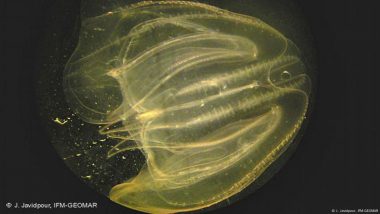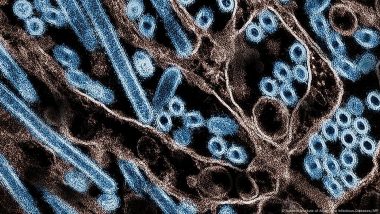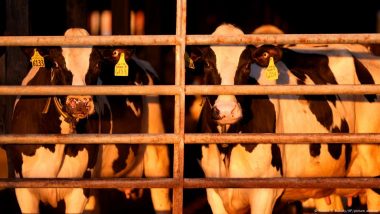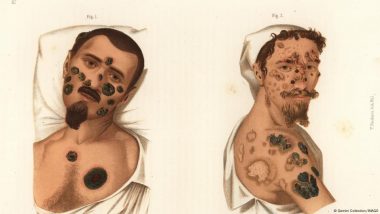Almost by chance, researchers in Norway found adult comb jellies reverse their development and become larva again when stressed by starvation. It helps them survive because larva eat less than the adults.It's not the first time that scientists have made a discovery about a slippery marine species by accident. You may have heard about the "immortal jellyfish" which was discovered by chance in the 1980s by two young scientists, Christian Sommer and Giorgio Bavestrello .
They found that when adult Turritopsis dohrnii jellyfish were stressed, they reverted to an earlier stage in their life-cycle — rather than die.
Normally, the adults (medusae) release a free-swimming larval stage of the organism known as planulae. The planulae form polyp colonies, and those colonies eventually release new medusae.
But, as their then-lab leader Ferdinando Boero once wrote in The Biologist magazine, Sommer and Bavestrello saw a process that was "like a butterfly transforming back into a caterpillar."
Jellyfish reverse their development to survive when stressed
The process is called reverse development. And it seems now that Turritopsis dohrnii is not the only jellyfish-like creature — known collectively as "jellies" — able to do it.
Two scientists in Norway have discovered that comb jellies from the species Mnemiopsis leidyi reverse from a mature "lobate", or adult with lobes, to an early larval-state — also when stressed — just like the "immortal" Turritopsis dohrnii.
"'Immortal' is a bit of a misleading term. 'Reverse development' is more correct," said Pawel Burkhardt, one of the researchers, an evolutionary neuroscientist and group leader at the Michael Sars Centre, University of Bergen.
Burkhardt's colleague and lead author of the study, Joan Soto-Angel, used two methods to stress the comb jellies: prolonged starvation and physical injury or "lobectomy" (cutting the adult lobes). Both stressors were followed by a low feeding regime.
They found that animals subjected to lobectomy treatment had lower mortality rates and higher reversion success, with six out of fifteen (40%) fully reversed. In contrast, prolonged starvation only yielded seven out of 50 (14%) fully reversed animals.
"The unique thing about Mnemiopsis is that you have a single individual, which can reverse to a single larva," said Burkhardt. "It's an individual, so you can trace it. And with Turritopsis, it's not so clear."
This is because Turritopsis reverses into a colony of individuals, rather than a single larva. So you can't be sure that you're witnessing the life-cycle and survival strategy of a single specimen, which is important for scientists wanting to map out the process precisely.
The findings are significant, wrote Ferdinando Boero, who was not part of the latest research, in an email to DW: "They show that reverse development can occur also in non-cnidarians, so expanding the range of body plans that are able to do it."
To explain Boero's terminology: Both Turritopsis dohrnii and Mnemiopsis leidyi are "jellies", but they belong to different groups, cnidarians and ctenophores, and each have different "body plans". So different structures, or what scientists call "morphological" features. Turritopsis dohrnii are cnidarians, Mnemiopsis leidyi are ctenophores.
How reverse development allows comb jellies to survive harsh conditions
If we stick now with the ctenophore Mnemiopsis leidyi, the scientists showed that the species can regrow again into adults after their reversal into larva.
"It's very dynamic. Once they are back at the larval, or cydippid stage, if they are provided with enough food, they can grow back to an adult," said Burkhardt.
And this cycle could theoretically repeat again and again. Though it doesn't necessarily mean that they live forever. They could get eaten by a predator, for example.
But since they are a "highly invasive species," these findings may also have an ecological impact.
"There is a theory that the collapse of fisheries in the Black Sea [in the 1990s] was caused by Mnemiopsis," said Burkhardt. "Since the larva has tentacles, it feeds completely differently from an adult — an adult needs way more food and the larva needs much less — so it may be a strategy to survive harsh conditions."
Could humans do reverse development?
Aging is sometimes cited as the main cause of death. It is through aging that our cells degenerate and our brain plasticity — the capacity of the nervous system to adapt over time — slows.
Increasingly, some researchers are looking into ways of slowing the human aging process, even if only to make life more comfortable as we approach a natural death.
But while research into Turritopsis dohrnii has shown some of what we know about jellyfish is transferrable to humans, that work has yet to be done with Mnemiopsis leidyi.
"I can only speculate," said Burkhardt. "[But there appears to be] a major rearrangement in the nervous system [between the two stages] and that's what we want to look at in the next couple of years."
What's clear so far is that when Mnemiopsis leidyi regress, they grow a new "structure" — tentacles, which the adult doesn't have — and the tentacles need a specific nervous system to function. And genes need to be turned on to create that nervous system. But how? That is the question.
"The observation of the pattern of reverse development is the first step," said Boero. "Then we need to ascertain the genetic processes that regulate the normal developmental patterns, so as to restart development. If a genetic switch exists, we might try to see if it works also in human cells. The rejuvenation of humans, though, is highly unfeasible due to our low plasticity."
And, as Boero added: Things might just be even more complex than that.
Edited by: Derrick Williams
Primary source:
Reverse development in the ctenophore Mnemiopsis leidyi, a "brief report”, published Joan Soto-Angel and Pawel Burkhardt in PNAS (October 2024)
(The above story first appeared on LatestLY on Nov 14, 2024 06:00 PM IST. For more news and updates on politics, world, sports, entertainment and lifestyle, log on to our website latestly.com).













 Quickly
Quickly





















